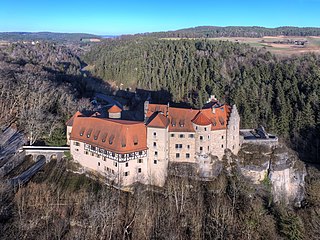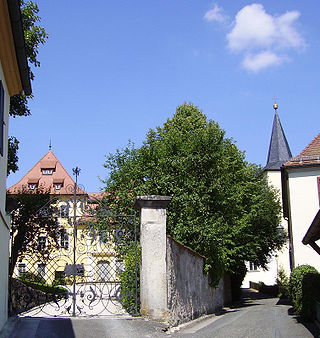
Hamburg, officially the Free and Hanseatic City of Hamburg, is the second-largest city in Germany after Berlin, as well as the overall 8th-largest city and largest non-capital city within the European Union with a population of over 1.9 million. Hamburg's urban area has a population of around 2.5 million and is part of the Hamburg Metropolitan Region, which has a population of over 5.1 million people in total. At the southern tip of the Jutland Peninsula, Hamburg stands on the branching River Elbe at the head of a 110 km (68 mi) estuary down to the North Sea, on the mouth of the Alster and Bille. Hamburg is one of Germany's three city-states alongside Berlin and Bremen, and is surrounded by Schleswig-Holstein to the north and Lower Saxony to the south. The Port of Hamburg is Germany's largest and Europe's third-largest, after Rotterdam and Antwerp. The local dialect is a variant of Low Saxon.

The Alster is a right tributary of the Elbe river in Northern Germany. It has its source near Henstedt-Ulzburg, Schleswig-Holstein, flows somewhat southwards through much of the Free and Hanseatic City of Hamburg and joins the Elbe in central Hamburg.

Hamburg was founded in the 9th century as a mission settlement to convert the Saxons. Since the Middle Ages, it has been an important trading center in Europe. The convenient location of the port and its independence as a city and state for centuries strengthened this position.

Střekov Castle is a ruined castle in Ústí nad Labem in the Central Bohemian Highlands in the Czech Republic. It is perched atop a cliff above the Elbe river. It was built in the 14th century to protect the waterway and collect duties on transported goods, and is renowned for its impressive views.

Rainer Fetting is a German painter and sculptor.
Transport in Hamburg comprises an extensive, rail system, subway system, airports and maritime services for the more than 1.8 million inhabitants of the city of Hamburg and 5.3 million people in the Hamburg Metropolitan Region.

Friedensburg Castle is an early 16th-century castle overlooking the valley of the Sormitz at Leutenberg in southeast Thuringia, Germany. It was formerly the residence of the Counts of Schwarzburg-Leutenberg and today is a dermatological medical facility.

Ludger Fischer is a German historian on building history, reviewer of contemporary architecture and political scientist.

Pillnitz Palace is a restored Baroque schloss at the eastern end of the city of Dresden in the German state of Saxony. It is located on the right bank of the River Elbe in the former village of Pillnitz. It was the summer residence of many electors and kings of Saxony; it is also known for the Declaration of Pillnitz in 1791.

The Metzendorf-Woxdorf head of burial is the Neolithic burial of a single human skull that was found in 1958 in the Seevetal district of Woxdorf, in Harburg, in Lower Saxony. The find is currently the only one of its kind of the Single Grave Culture in Germany and is in the permanent exhibition of the Archaeological Museum Hamburg in Harburg, Hamburg.

The Bishop's Tower, or Bishop's Castle, is an archaeological site in the historic city center of Hamburg, Germany, containing the oldest known remains of a stone building in the city. The site includes the foundations of a circular tower and a well, originally believed to represent the 11th-century stone residence of Archbishop Adalbrand of Bremen. Later finds, however, disproved this theory and it is now considered to be part of a 12th-century defensive structure.

Treva is the historical original name-during the short-lived creation of the Roman province of Germania-of the actual city of Hamburg in Germany.

Gößweinstein Castle, also called Schloss Gößweinstein, is a mediaeval hilltop castle in Gößweinstein in the county of Forchheim in the German state of Bavaria. It towers high above the market town and the River Wiesent and may have been the inspiration for Richard Wagner's grail castle in his opera, Parsifal. The castle is a Bavarian listed building, no. D-4-74-129-10.

Kohlstein Castle is situated on a rocky hillock in the village of Kohlstein northwest of Tüchersfeld and is the most recently built castle in Franconian Switzerland. It is also one of the smallest and most romantic castles. Today it is in private ownership and may not be visited.

Rabenstein Castle is a former high medieval aristocratic castle in the municipality of Ahorntal in the Upper Franconian county of Bayreuth in the German state of Bavaria.

Schloss Unterleinleiter is a German schloss in Unterleinleiter in Upper Franconia. The building has 29 rooms and is privately owned.

Schloss Kunreuth is situated on the northwestern edge of the eponymous village of Kunreuth which is part of the collective municipality of Gosberg in the county of Forchheim, in the province of Upper Franconia in the south German state of Bavaria.

Schloss Wiesenthau stands on the northeastern edge of the eponymous municipality at the foot of the Ehrenbürg in northern Bavaria. The Renaissance building is a three-winged country house with 4 mid-16th century corner towers and the remains of an enceinte.
Georg Ulrich Großmann is a German art historian. He was general director of the Germanisches Nationalmuseum in Nuremberg.
The New Castle(Hamburg) or Neue Burg was a medieval saxonian castle in the town of Hamburg and is the successor to the Hammaburg. In the 11th century it was the biggest castle in northern Germany and the last one built in the traditional saxonian style, only consisting of wood and earth.






















